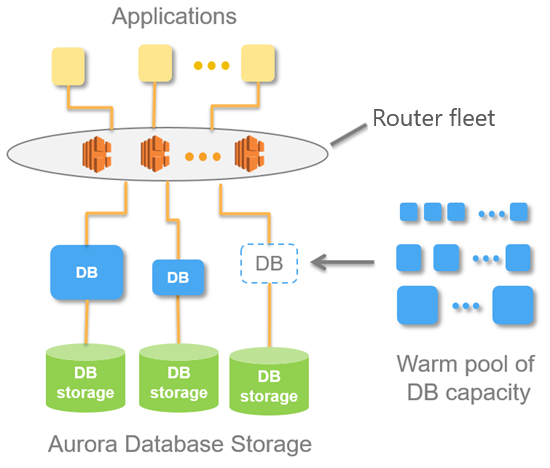There is also a Aurora Serverless option which scales the number of ACUs (Aurora Capacity Units) according to the load.

Sizing
Instead of provisioning and managing database servers, you specify ACUs. Each ACU is a combination of processing and memory capacity. Database storage automatically scales from 10 GiB to 128 TiB, the same as storage in a standard Aurora DB cluster.
You can specify the minimum and maximum ACU. The minimum Aurora capacity unit is the lowest ACU to which the DB cluster can scale down. The maximum Aurora capacity unit is the highest ACU to which the DB cluster can scale up. Based on your settings, Aurora Serverless automatically creates scaling rules for thresholds for CPU utilization, connections, and available memory.
Aurora Serverless manages the warm pool of resources in an AWS Region to minimize scaling time. When Aurora Serverless adds new resources to the Aurora DB cluster, it uses the router fleet to switch active client connections to the new resources. At any specific time, you are only charged for the ACUs that are being actively used in your Aurora DB cluster.
Aurora Serverless scales up when capacity constraints are seen in CPU or connections. It also scales up when it detects performance issues that can be resolved by scaling up.
After scaling up, the cooldown period for scaling down is 15 minutes. After scaling down, the cooldown period for scaling down again is 310 seconds.
Reconfiguration
After you configure an Aurora Serverless DB cluster, you can modify its scaling configuration with the AWS Management Console, the AWS CLI, or the RDS API.
You can set the following specific values:
- Minimum Aurora capacity unit – Aurora Serverless can reduce capacity down to this capacity unit.
- Maximum Aurora capacity unit – Aurora Serverless can increase capacity up to this capacity unit.
- Timeout action – The action to take when a capacity modification times out because it can’t find a scaling point. Aurora can force the capacity change to set the capacity to the specified value as soon as possible. Or, it can roll back the capacity change to cancel it. For more information, see Timeout action for capacity changes.
- Pause after inactivity – The amount of time with no database traffic to scale to zero processing capacity. When database traffic resumes, Aurora automatically resumes processing capacity and scales to handle the traffic.
Aurora Serverless Failover
If the DB instance for an Aurora Serverless DB cluster becomes unavailable or the Availability Zone (AZ) it is in fails, Aurora recreates the DB instance in a different AZ. We refer to this capability as automatic multi-AZ failover.
This failover mechanism takes longer than for an Aurora Provisioned cluster. The Aurora Serverless failover time is currently undefined because it depends on demand and capacity availability in other AZs within the given AWS Region.
Because Aurora separates computation capacity and storage, the storage volume for the cluster is spread across multiple AZs. Your data remains available even if outages affect the DB instance or the associated AZ.
Pricing
Costs is from $0.06 per ACU per hour plus the usual database storage and IOs request charges.
